Testing 4G LTE from Yota, MegaFon, MTS and Beeline in Moscow
I will not cut a big secret, if I say that with the arrival of the fourth-generation networks, the mobile Internet made great races, even to some extent the domestic Internet. Personally, I noticed that I was no longer trying to reach the public Wi-Fi with the 4G icon in your phone. LTE makes it possible to watch multimedia content in maximum quality and communicate with friends and relatives through video calls without pixelization of the image. Of course, this type of connection is not so large, but at least in large cities it comes quite actively. In Moscow, this service represents four providers, and we decided to spend a small test, collecting a bit of statistics.
For testing, we needed four identical smartphones with LTE support. And since Huawei is one of the LTE locomotives, the choice fell on the Huawei Ascend G6 model (review). This device is perfect for the role of an average solution with LTE support and good work speed. Personally, the device was very similar to me as an inexpensive and high-quality solution. The firmware on all devices was installed last.

4) At the last stage of testing, unfortunately, one of the testing resources fell off, so the data on it is not entirely complete.
However, in spite of all these "but", the experiment we spent the useful information on synthetic tests and network behavior in various conditions.
So, as we tested. The cycle is quite simple. The sequence of actions will help if you yourself want to check the screenshots that we posted separately. For starters, we, of course, are determined with the position on the map using "Google Maps". With this test, we check the number of lost packages, which indicates the instability of data transmission. To test outgoing speed, we used the iPerf client by selecting an open server and specifying the following command "-c iPerf.ELTEL.NET -P 10 -W 100K". This command makes 10 file sending, issuing general statistics and speed. To analyze incoming speed, we simply decided to use the "Mail.ru cloud". Of course, we spent a couple of times downloading files with fast servers, but in general the main task is to find out a real version. Without SpeedTest-measurement, it will act as an indicator pointing to the network state.
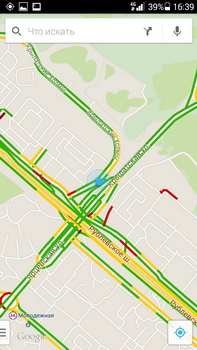
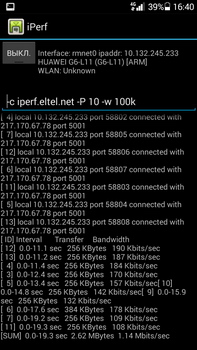
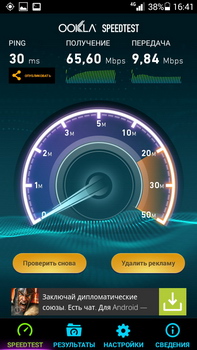
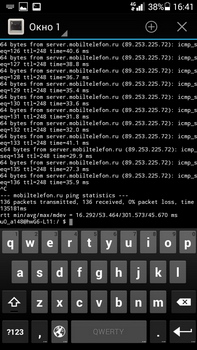
After multiple passes, we revealed that SpeedTest is really quite suitable as the main determinant of the network quality. Of course, you should not believe in the numbers above 60 Mbps on the entrance, but in general, if SpeedTest writes about 30 Mbps, then it is. With outgoing traffic, the situation is somewhat different. In this case, it all depends on the provider and Yota stated by the fact that its performance in Speedtest and IPERF was very different, indicating that the provider cuts upload in the reality, while the synthetic test shows high numbers. But the remaining providers for large "virtual" figures showed similar results in combat task. Returning to the question of downloading, in a pair of cases we met the situation when the LTE speed indicators were very low, in a pair of places for the sake of the experiment, a comparison was made with 3G. According to the results, it turned out that even with a low-level fourth-generation network level, it still overtook HSDPA in downloading large-volume files. Interesting was the comparison of Yota with MegaFon. In general, network indicators were very close to each other, but sometimes tough discrepancies still do not allow it to be argued that the same basic stations (BS) are used.
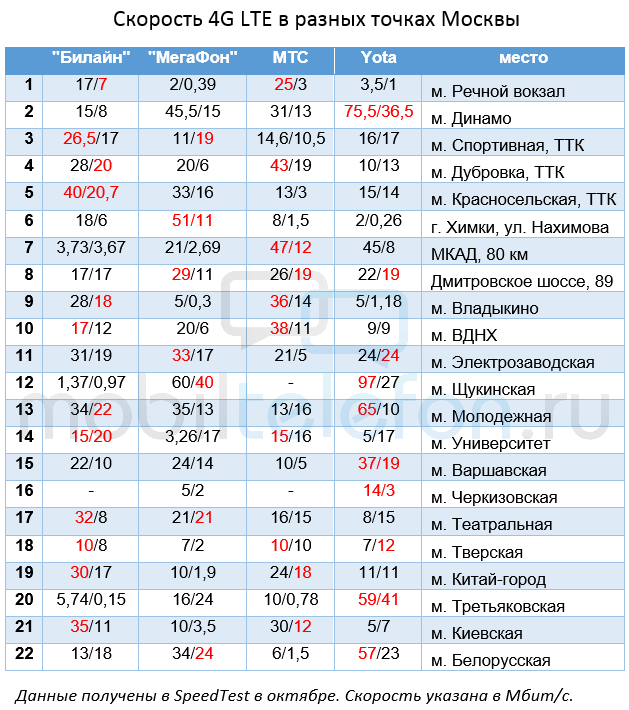
Below I will describe each of the 22 points with small comments. Screenshots from SpeedTest will be the main indicators. To summarize common results, I will introduce 3 ball values, where the score will be deducted when the speed value in SpeedTest is less than 10 Mbps, or when losing packages more than 5%. In the absence of 4G, the operator at the point will receive 0. Archive with screenshots from SpeedTest you can download from here.
1. Start started with m. River station on day off in the evening. At this point, Yota and MegaFon showed very badly. Both providers had not only speed problems, but also with a small loss of packages in the amount of 1-2%.
2. M. Dynamo, Mail.ru tower. Relatively low indicators at Bilain, but even with them problems with the loading of HD content in Youtube did not occur.
3. M. Sportiv. Beeline, despite the leadership in Speedtest, showed a greater loss of packages in the amount of 6%. This and part of subsequent tests was carried out in the stream of machines on the TTK (the third transport ring), so there is a strong loading of networks.
4. M. Dubrovka. The low level was Yota, while the rest showed good results.
5. M. Krasnoselskaya. All subjects showed excellent results.
6. Making a big hook for changing the iron horse, we found themselves in the city of Khimki on the street. Nakhimova. In this place, Yota and MTS showed very poorly, while in the courtyards it was generally possible to catch an empty zone. However, Beeline again showed a loss of packages by 6%.
7. MKAD, 80 km. Low-speed outsider was only Beeline, but without loss of packages.
8. Dmitrovskoe highway, d. 89. Stop snack. All participants gave rise to above 20 Mbit / s, and Beeline has a loss of packages amounted to 3%.
9. M. Vladikino. In this region, all providers showed a small loss of packages. However, "MegaFon" and Yota were worse than all, showing not only weak speed, but also losses more than 5%. It is possible, there is a common BS.
10. M. VDNH. Yota in the area there is a speed loss, in comparison with other operators.
11. M. Electrobodskaya. All demonstrated high-quality data transfer. The SpeedTest MTS showed a great value of the response, but in the terminal these figures were not confirmed.
12. New day, again weekend, again evening. MegaFon and Yota pleased the connection speed, but Beeline showed itself very weak, but it is not so bad like MTS, where we did not see the LTE connections at all.
13. M. Youth. The less than all in the test showed MTS, but still it is above 10 Mbps (the maximum declared speed 3G according to the specifications).
14. M. University. In this area, MegaFon and Yota have minor packet losses less than 5% and low download speed. But the rate of return, on the contrary, it turned out high, and here, as before, it is clear that Yota intends to cut upload up to 1 Mbit / s.
15. M. Warsaw. MTS walks on the face of 10 Mbps. So, 1 point is deprived as prophylaxis.
16. M. Cherkizovskaya. Another black hole. This time for MTS and for Bilain. However, MegaFon loses their score for low speed.
17. New day. This time, weekly, and here we will check the center of Moscow. M. Theatrical, the test was conducted after the presentation of Huawei Honor 6 (video) (yes this is such a coincidence). This time Yota showed a decrease in speed in comparison with opponents. MTS also showed loss of packages in 3%.
18. M. Tverskaya. Many Internet users, and sitting nearby corporations. Everyone was either lower or on the border. MTS and MegaFon distinguished the loss of packages at the level of 5%.
19. M. China-city. On the border was "MegaFon", Yota was also close, but 11.5 Mbit / s is still not 3G. MTS and Beeline performed perfectly.
20. M. Tretyakovskaya. In this section, Beeline has shown himself worse than all, weak digits in Speedtest and loss of packages as much as 27%. Minus score gets MTS for the border state.
21. Gone heat. M. Kiev, Kiev station, almost an hour of peak. Beeline and MTS coped without problems, but Yota and MegaFon saved slightly.
22. Endpoint. Belarusian station. 18.00, rush hour. Only MTS really coped, showing low speed and 14% packet loss. The rest coped with a bang.
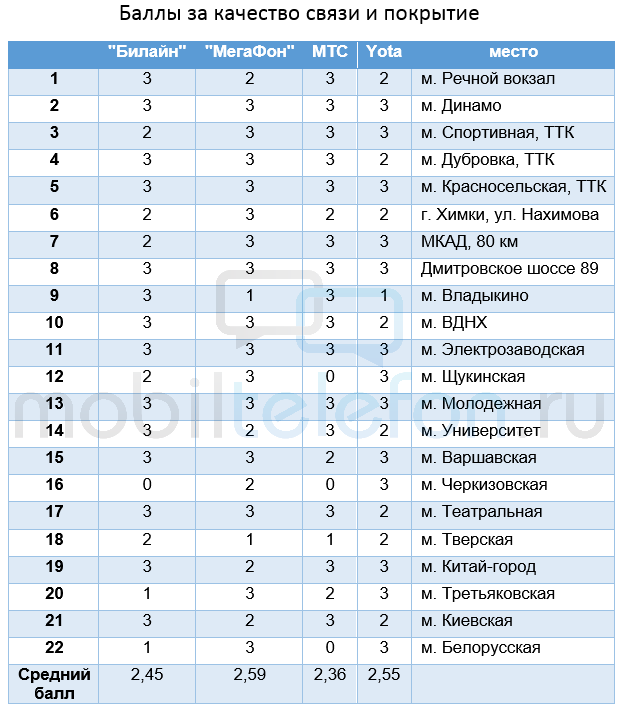
As can be seen, in most places operators show good results. The speed on average in Moscow is kept in the area of \u200b\u200b20 Mbps. Of course, due to the large loading of the metropolis of 4G-networks, it is difficult to show all your capabilities. But the final consumer maximum speed is not so important, and the current indicators are enough for comfortable work.
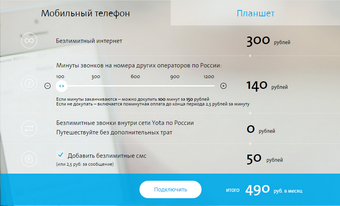
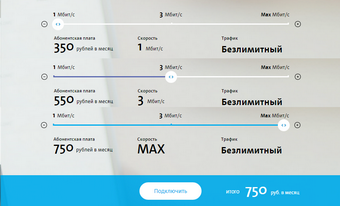
As already mentioned, it was the appearance of Yota as a mobile operator forced to carry out this test. Many people are interested in the declared unlimited Internet from this operator. But, alas, he has limitations. First, the already mentioned trimming of the velocity of the Applada, which for many negates the advantage of LTE in the form of a quick download of files. Secondly, when distributing the Internet by Wi-Fi, speed cuts up to 1 Mbps (that is, you cannot use the Yota SIM card for a comfortable access to the Internet from other devices). The cost of unlimited traffic is 300 rubles, but it is impossible to buy it separately without a package, and this value increases to the minimum 440 rubles per month. The disadvantage is the presence of a separate fare for tablets (iPad and devices that are not capable of making calls and having a large diagonal will be perceived by the tablets.
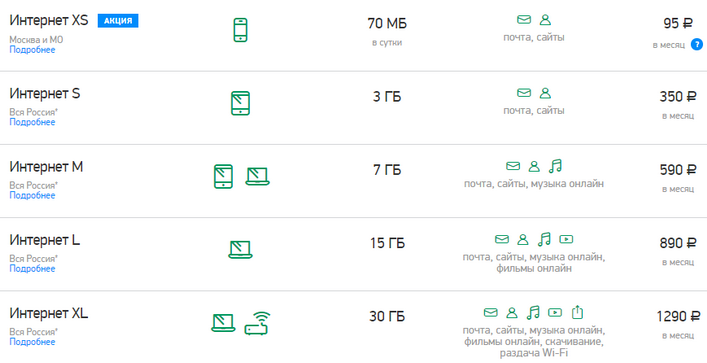
In MegaFon, we have connected the "Internet S" rate worth 350 rubles, including 3 GB of traffic - this volume will be for the extension.
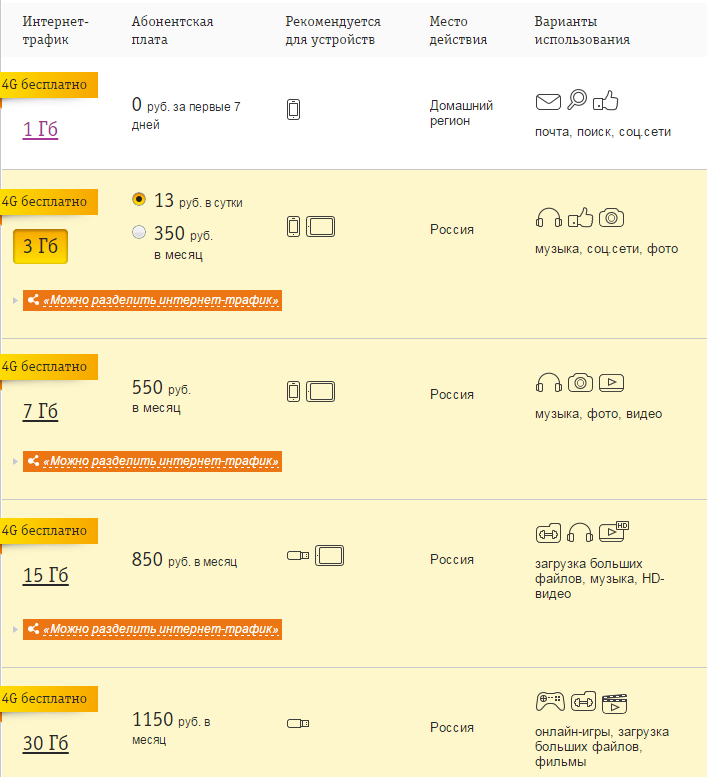
At the time of the start of testing in the Beeline tariff line, there was no "Highway" tariff line, which gives the same 3 GB of traffic for the same 350 rubles, but at the moment before January, the provider acts the service "the faster, the couple", which is not Consides 4G traffic. It would be nice if they extended this campaign on an ongoing basis, making it a competing of Yota. We used the "All 900" package, the cost of which is 30 rubles per day (5 GB of traffic, call package and SMS) are given.
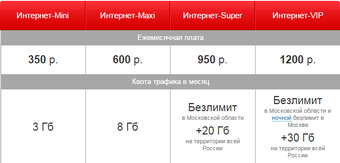
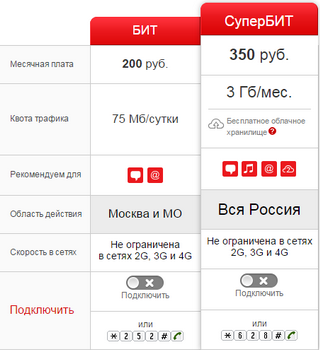
MTS has two options for providing the Internet: Package Packages and Bit Service. In our case, the bit would be inconvenient due to the limitations of high-speed daytime traffic. The cost of the standard package for 3 GB is standard 350 rubles. The same amount stands relatively unlimited "Superbits", but it has a large number of restrictions. In fact, it will be interesting to those who are not fully confident in the traffic consumed by him, giving the opportunity not to spend more.
The choice of cellular operator needs to be approached individually. You need to weigh not only the tariff options and the quality of the services provided, but also personal experience with operators, as well as familiar experience. One way or another, having considered the work of 4G in Moscow, it can be said that the operators were not bad, providing users with accessible and fast mobile Internet. Some one leader is difficult to identify, everyone coped with plus minus equally. However, high-quality growth is still required, especially in the conditions of increasing accessibility of LTE smartphones. Let's hope, the decline in the economy does not have operator plans for the introduction of 4G in new cities and more people can work on the Internet at high speeds.
the site is grateful to Huawei for the Huawei Ascend G6 test.
 Service "Prohibition of Calls" from MegaFon
Service "Prohibition of Calls" from MegaFon Tele Support Service2: Free Phone
Tele Support Service2: Free Phone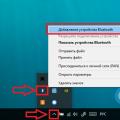 How to connect bluetooth headphones to a computer?
How to connect bluetooth headphones to a computer?